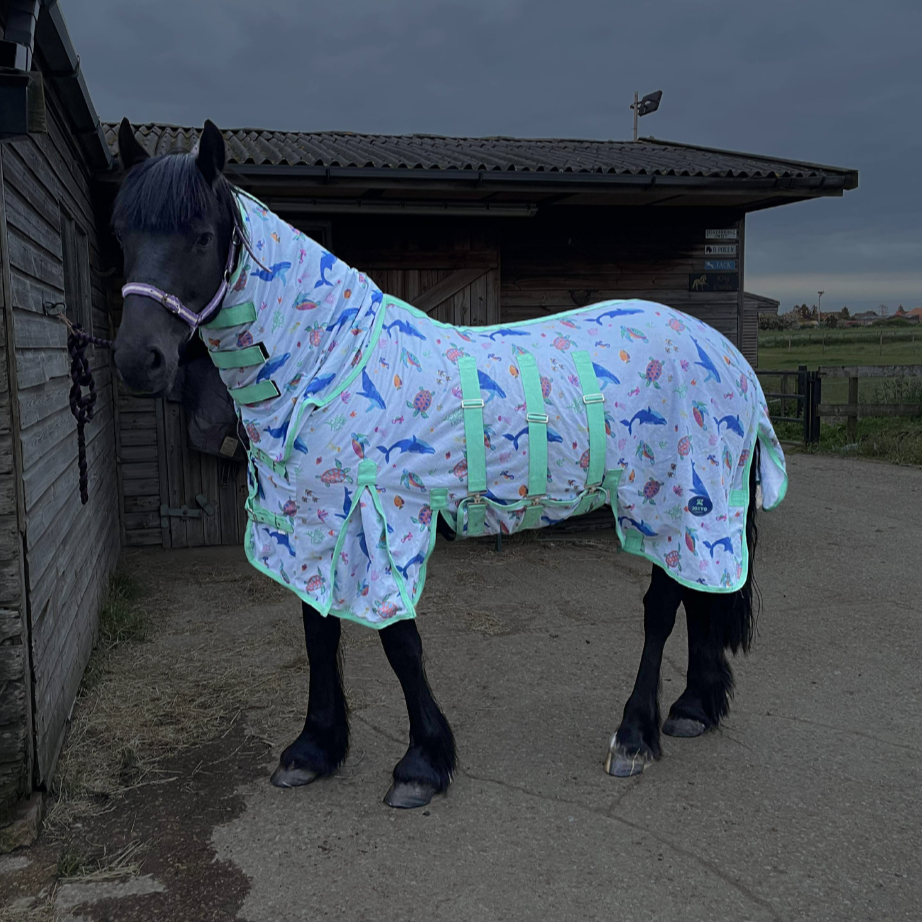Culicoides Hypersensitivity also known as ‘Sweet Itch’
A type of equine eczema that can be caused by Insect Bite Hypersensitivity or Summer Seasonal Recurrent Dermatitis.

Culicoides hypersensitivity, commonly known as Sweet Itch, is one of the most common allergic skin conditions affecting horses. Caused by an allergic reaction to the bites of Culicoides midges—tiny, flying insects that are so small they are sometimes referred to as "no-see-ums". This condition can cause intense itching, hair loss and skin damage. Sweet itch can significantly affect a horse’s welfare, behaviour and appearance, especially during the warmer months when midges are most active.
This article will explore the causes, clinical signs, treatment options, and management strategies for Culicoides hypersensitivity, helping owners understand and effectively support horses affected by this challenging condition.
What Causes Sweet Itch?
Sweet itch is a seasonal allergic dermatitis caused by an overactive immune response to proteins found in the saliva of Culicoides spp. midges. When these midges bite a horse, the immune system in susceptible individuals overreacts, triggering intense inflammation and itching in the skin. Not all horses are affected, but those with a genetic predisposition or heightened sensitivity may develop severe symptoms.
Culicoides midges are most active during spring, summer and early autumn, particularly around dawn and dusk. These tiny insects thrive in warm, moist environments, such as near standing water, marshy fields, or manure heaps. The allergy is non-contagious but tends to recur annually in affected horses.
Key contributing factors include:
- Genetics: Some breeds, such as Icelandic horses, Welsh ponies, and Shires, appear more predisposed to developing sweet itch.
- Environmental Conditions: Warm weather, damp environments, and low wind conditions increase midge activity.
- Repeated Exposure: Horses that are continually exposed to midge bites are more likely to develop or worsen their hypersensitivity over time.
Clinical Signs of Culicoides Hypersensitivity
Sweet itch primarily affects the skin, but the resulting irritation can have significant behavioural and secondary health impacts. Clinical signs typically become noticeable in late spring or early summer, intensify through the season before usually subsiding as temperatures drop.
Common signs include:
- Intense Itching (Pruritus): Horses with sweet itch often exhibit relentless itching, rubbing themselves against fences, trees, or stable walls to relieve discomfort.
- Hair Loss: Persistent rubbing leads to patchy hair loss, particularly around the mane, tail base, withers, belly, and face.
- Thickened, Scabby Skin: Over time, affected areas can become thickened, crusty, and inflamed due to trauma and secondary infection.
- Open Sores and Bleeding: Chronic rubbing and biting can lead to open lesions that may attract flies and become infected.
- Behavioural Changes: Due to constant irritation, some horses may become restless, anxious, or unwilling to be handled or ridden.
Sweet itch is often seasonally recurrent, with the same pattern of symptoms reappearing year after year unless proactive steps are taken.
Diagnosis of Sweet Itch
Diagnosing sweet itch is typically based on clinical signs and seasonality, but a vet may perform additional tests to rule out other skin conditions, such as lice, mites, ringworm, or food allergies.
Key diagnostic steps include:
- History and Clinical Examination: The timing of symptoms, specific areas affected, and behavioral patterns can strongly indicate sweet itch.
- Intradermal Allergy Testing: This test can help confirm sensitivity to Culicoides and other potential allergens. A small amount of allergen is injected under the skin to observe the reaction.
- Skin Scrapings or Biopsies: These can help rule out parasitic or fungal infections, especially in early or atypical cases.
A confirmed diagnosis helps tailor the most effective treatment and management approach for each individual horse.
Treatment of Sweet Itch
While there is no cure for Culicoides hypersensitivity, several treatments can reduce the severity of symptoms and provide relief. The aim of treatment is to reduce the allergic response, soothe inflammation and prevent secondary infections.
Anti-inflammatory Medications:
Corticosteroids such as dexamethasone or prednisolone can reduce inflammation and itching. These are typically used for short periods under veterinary guidance due to potential side effects with long-term use. Although uncommon, side effects may include laminitis, particularly in prone horses or those with pre-existing conditions such as Cushing’s or Insulin Dysregulation/EMS.
Topical steroids may be used on localized lesions to provide targeted relief with fewer systemic risks.
Antihistamines:
Oral antihistamines can help control itching, although results can be disappointing in horses versus other species such as humans and dogs. This is due to a difference in the histamine receptor physiology of horses. The benefit of antihistamine medication in horses often depends on timing (best when started early in the season) and the individual horse’s response.
Antimicrobial Treatments:
Secondary bacterial infections are common in horses with open sores. Topical or systemic antibiotics may be prescribed if the treating vet recognises secondary infection.
Soothing Topical Applications:
Medicated shampoos, creams and sprays can help relieve itching and calm inflamed skin.
Fly repellents
Although not a treatment, fly repellents may reduce further midge bites so can be an effective part of the strategy to reduce severity of clinical signs. This is discussed further below in ‘management strategies for Sweet Itch’.
Applying long-lasting repellents regularly can help deter midges. Products containing DEET, citrodiol or other natural based essential oils can be very effective. Frequent reapplication helps to maximise the benefit.
Allergen-Specific Immunotherapy (Desensitization):
In some cases, allergen-specific injections based on allergy test results can help reduce sensitivity over time, though this treatment requires commitment and close veterinary oversight.
Management Strategies for Sweet Itch
Prevention and environmental management are the most effective long-term strategies for controlling sweet itch. By reducing exposure to biting midges, owners can dramatically decrease the likelihood of flare-ups.
Physical Barriers:
- Fly Rugs and Masks: Lightweight, full-coverage fly rugs with belly bands and neck covers offer physical protection from midge bites. Fly masks can also protect the face and ears.
- Stabling at Peak Midge Times: Midges are most active at dawn and dusk. Keeping horses indoors during these hours can significantly reduce bites.
- Fine-Mesh Screens: Installing mesh on stable windows and doors can keep midges out of barns.
Environmental Management:
- Eliminate Standing Water: Reducing stagnant water sources helps limit breeding grounds for midges.
- Pasture Management: Keep horses away from wet, low-lying areas and rotate grazing fields when possible. Keep muck heaps away from areas where horses graze.
- Fans: if effectively fitted inside stables or barns, these can make it harder for midges to fly and therefore decrease exposure.
Nutritional Support:
While this blog does not focus on supplements, maintaining a healthy skin barrier through proper nutrition supports overall resilience against allergies and secondary skin damage.
Seasonal Planning:
In severe cases, relocating horses to midge-free areas (e.g., coastal or breezy regions) during peak seasons may be considered.
Conclusion
Culicoides hypersensitivity, or sweet itch, is a frustrating and often debilitating condition for horses and owners alike. However, with early intervention, consistent management and veterinary guidance, it is possible to minimize the impact of this seasonal allergy and maintain your horse’s comfort and well-being.
By recognizing the signs, implementing protective strategies, and treating symptoms effectively, horse owners can significantly improve the quality of life for horses prone to sweet itch. If your horse shows symptoms of sweet itch, consult your veterinarian to develop a tailored care plan that meets your horse’s specific needs.
Written by: Dr Andy Richardson, Veterinary Director. BVSc Cert AVP(ESM) MRCVS.



